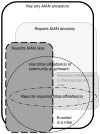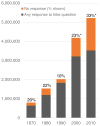Counting America's First Peoples
- PMID: 29805177
- PMCID: PMC5967841
- DOI: 10.1177/0002716218766276
Counting America's First Peoples
Abstract
The descendants of the First Peoples of the Americas (labeled "American Indians and Alaska Natives" in the federal definition) are a particularly challenging group to count in censuses. In this review, I describe some enumeration issues and then outline what we have learned about American Indians and Alaska Natives from efforts that rely on individuals' answers to census questions on race, ancestry, ethnicity, and tribe. Those who do not report a tribe and those who change their race response from one census to another complicate these efforts. Tribal self-enumeration and indigenous data sovereignty may improve data about some portions of the population. Census and survey enumeration efforts should continue to separate the concepts of race, ancestry, and tribe lest the various sub-populations become indistinguishable in the data, making the data much less useful and possibly misleading.
Keywords: American Indians and Alaska Natives; Indigenous; Self-Identification; Tribe; U.S. Census.
Figures
Similar articles
-
American Indians without Tribes in the 21st Century.Ethn Racial Stud. 2013;36(11):1910-1934. doi: 10.1080/01419870.2012.692800. Ethn Racial Stud. 2013. PMID: 25346556 Free PMC article.
-
Using GIS in a first national mapping of functional disability among older American Indians and Alaska Natives from the 2000 census.Int J Health Geogr. 2006 Sep 1;5:37. doi: 10.1186/1476-072X-5-37. Int J Health Geogr. 2006. PMID: 16948854 Free PMC article.
-
Historical trauma among Indigenous Peoples of the Americas: concepts, research, and clinical considerations.J Psychoactive Drugs. 2011 Oct-Dec;43(4):282-90. doi: 10.1080/02791072.2011.628913. J Psychoactive Drugs. 2011. PMID: 22400458
-
Cardiovascular health among American Indians and Alaska Natives: successes, challenges, and potentials.Am J Prev Med. 2005 Dec;29(5 Suppl 1):11-7. doi: 10.1016/j.amepre.2005.07.023. Am J Prev Med. 2005. PMID: 16389120
-
American Indians and Alaska Natives--overview of the population.Public Health Rep. 1996;111 Suppl 2(Suppl 2):49-50. Public Health Rep. 1996. PMID: 8898774 Free PMC article. Review.
Cited by
-
The US Census and the People's Health: Public Health Engagement From Enslavement and "Indians Not Taxed" to Census Tracts and Health Equity (1790-2018).Am J Public Health. 2019 Aug;109(8):1092-1100. doi: 10.2105/AJPH.2019.305017. Epub 2019 Jun 20. Am J Public Health. 2019. PMID: 31219723 Free PMC article.
-
Indigenous Smoking Behaviors in Olmsted County, Minnesota: A Longitudinal Population-Based Study.Mayo Clin Proc. 2022 Oct;97(10):1836-1848. doi: 10.1016/j.mayocp.2022.03.019. Mayo Clin Proc. 2022. PMID: 36202495 Free PMC article.
-
Change in Health Status Among American Indian/Alaska Native Adolescents Living Outside of Tribal Land in California Before and During the COVID-19 Pandemic.J Racial Ethn Health Disparities. 2025 Mar 19. doi: 10.1007/s40615-025-02387-9. Online ahead of print. J Racial Ethn Health Disparities. 2025. PMID: 40106184
-
Data impacts of changes in U.S. Census Bureau procedures for race and ethnicity data.SSM Popul Health. 2025 Jan 9;29:101742. doi: 10.1016/j.ssmph.2024.101742. eCollection 2025 Mar. SSM Popul Health. 2025. PMID: 39897609 Free PMC article.
-
A systematic review of responsible stewardship of research and health data from Indigenous communities.NPJ Digit Med. 2025 Aug 5;8(1):504. doi: 10.1038/s41746-025-01902-w. NPJ Digit Med. 2025. PMID: 40764752 Free PMC article.
References
-
- Cornell Stephen, Hartmann Douglas. Ethnicity and race: Making identities in a changing world. 2. Thousand Oaks, CA: Pine Forge Press; 2007.
-
- Eschbach Karl. Changing identification among American Indians and Alaska Natives. Demography. 1993;30(4):635–652. - PubMed
-
- Fallica Heather, Heimel Sarah, Jackson Geoff, Zhang Bei. 2010 Census Program for Evaluations and Experiments. Washington, DC: U.S. Census Bureau; 2012. 2010 Census Update Enumerate operations assessment: Update Enumerate production, Update Enumerate quality control, Remote Update Enumerate, and remote Alaska.
-
- Fox Jonathan, Rivera-Salgado Gaspar., editors. Indigenous Mexican migrants in the United States. Boulder, CO: Lynne Rienner Publishers; 2004.
Grants and funding
LinkOut - more resources
Full Text Sources
Other Literature Sources


